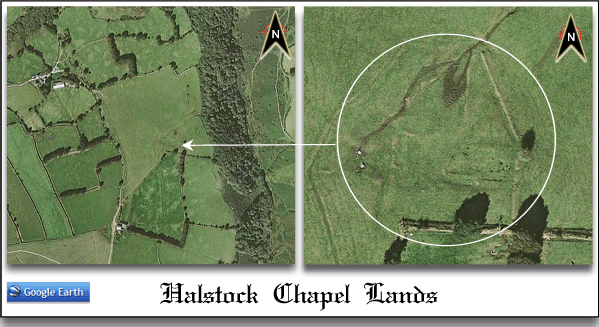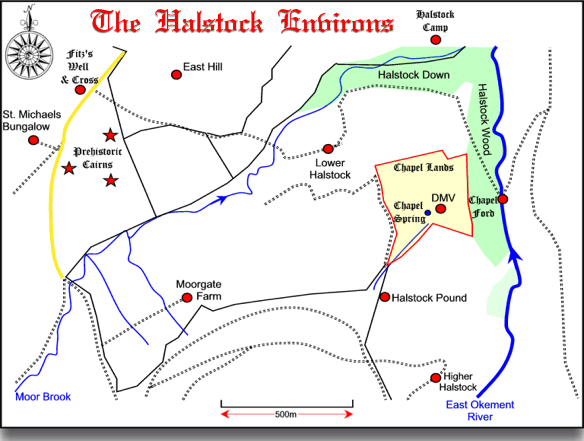
In the Perambulation of 1240 the following directions appear: ‘et inde linealiter usque ad vadum proximum in orientali parte capelle Sancti Michaelis … and thence in line to the next ford east of the chapel of St. Michael of Halgestoke.’ This is the first documented evidence of a chapel at Halstock and according to the Place Name Society the name derives from two Anglo Saxon words; hālga meaning hallowed or holy and stoc meaning place, thus giving ‘Holy Place’, (Glover et al. p. 203 and Clark Hall, 2004, pp. 167/322). So far everything ties in nicely; a chapel sited at a location which means, ‘holy place’ and an early mention in a document of 1240. Indeed today several other placenames in the locality back up such an idea; Chapel Lands, Chapel Ford, and Chapel Lands Spring.
In 1931 Dr. E. H. Young wrote the Parochial History of Okehampton in which he has the following to say about Halstock:
‘At Halstock, S.E. of the town, on the edge of the moor, ¼ mile beyond the wall of Okehampton Park and beyond the hamlet of that name, looking across the valley of the E. Okement, stood the Chapel of St. Michael of Halgestoke, thus named in the account of the perambulation of Dartmoor made on the 24th July 1240, when the ford, still called Chapel Ford, was one of the boundaries. Near the W. end of the site, a spring emerges from the hillside. How and why this chapel was built can only be conjectured. The line of the walls, barely discernible, measured apparently 21 ft x 14ft. It was successively in the care of Cowick Priory and Tavistock Abbey, but, in the Valor Ecclesiasticus (p.382), taken by order of Henry VIII at the reformation, although the rents for Halstock are included with those from ‘Inwardleigh and Chaggeford,’ no mention is made of the chapel among the spiritual possessions of Tavistock Abbey; so that even then, for some years it had fallen into disuse. Not improbably, like similar foundations recognised today only by the place-name Chapple (at Gidleigh, Bovey Tracy and elsewhere). Halstock was a votive chapel, perhaps originally marking the site of some hunting accident or even death.’, (pp. 60 – 61).
It has been suggested that the manor of Halstock was given to Cowick Priory (nr Exeter) by William Fitz Baldwyn around 1090 as it does not appear in the Domesday Book. In 1295 another document mentions a provost of Okehampton as being John Bere de Holdstocke, following this period the lands of Halstock passed from Cowick Priory to Eton finally ending up in the possession of Tavistock Abbey in 1464, (Radford, 2002, pp.26 -27). In 1506 the, ‘Villat de Hellestoke’ appears in the Forester’s accounts as paying two shillings and five pence as the venville rents for that year, (Rowe, 1988, p.143). This record appears some 29 years before the Valor Ecclesiasticus was commissioned in 1535 which shows there was clearly a settlement of sorts at Halstock. William Crossing (1990, p.193) mentions that the Rev. Fothergill wrote some notes on an essay written around 1839 by one William Bridges. Amongst these notes were some measurements that Fothergill made of the chapel which he estimated to be, ‘nine paces in length and four paces wide’. This building was placed inside an court like enclosure which measured 23 paces by 13 paces with what appeared to be a belfry or vestry at its western end. At a later date Crossing himself visited the site and took more accurate measurements of the chapel which he found to be 40 feet long and 24 feet wide, the court was 90 feet by 57 feet, the belfry or vestry was 30 feet by 25 feet.
It seems that somewhere along the line somebody has got the wrong measurements for the chapel as there is a huge difference between Young’s measurements of 21 x 14 feet and Crossing’s 40 x 24 feet. If Fothergill was a short man and his paces were 2 feet apart then his measurements would approximate with those of Crossing giving these dimensions the majority vote. Today the vestiges of a building standing in a court can clearly be discerned on aerial photographs as can be seen below:

All of this information leads us no nearer as to the actual location of the chapel and this opinion is shared by English Heritage who on their Pastscape Record for Halstock Chapel simply note that, ‘It’s precise location is not known‘. Linehan, (1966, p.127) notes that Halstock was at one time a fairly large settlement which consisted in 1586 of six tenements although yet again she gives no mention of the chapel’s location or existence. Now classed as a Deserted Medieval Village (DMV) it is but one of several deserted settlements to be found in the immediate area of Okehampton. One reason for the desertion of some of these DMVs was the creation of the deer park belonging to Okehampton Castle which meant the clearance of the settlements. However, Halstock lay outside the boundary of the park and so it’s unlikely that this was the cause of the decline.
One possible surviving relic of Halstock chapel is the ancient granite cross that stands by Fitz’s Well which lies just under a mile away to the north west of chapel lands. Crossing, (1987, p.123) again cites the work of Bridges noting that the cross was brought to the well from Halstock chapel. Sadly there are no dates mentioned but if this tradition is true it would suggest that the chapel was no longer in use when the cross was removed.

So, the location of Halstock Chapel can be assumed to be somewhere in the enclosure known as Chapel Lands and there is no record as to when it was established or when it fell into disuse. The earliest supposition is that it dated back to Saxon times and was associated with a small settlement that became a Deserted Medieval Village. The land was given to Cowick Priory by William Fitz Baldwyn and just possibly the chapel was established for votive purposes, maybe to mark a family death. Certainly the structure shown in the aerial photograph does seem to correlate with the measurements given by the various authors and it certainly is on an east – west orientation. What it needs is a visitation by a group of archaeologists and possibly a JCB digger?
There is one legend attached to the chapel which involved an Abbot of Tavistock Abbey. It transpired that a priest Halstock Chapel called ‘Bingie’ had offended the Abbot by denying his jurisdiction. After consultation with Rome it was the priest was threatened that if he did not conform then the chapel would be disestablished and the priest disendowed. However, if the priest, as a penance, were to take a sieve and line it with a sheep’s skin, go to Cranmere Pool and empty it then all would forgiven. The priest went to the pool with his sieve and fervently set to emptying it. Unfortunately he did such a good job that the rushing waters flowed on torrents from the pool as it passed the chapel the deluge carried away the chapel. So powerful was its force that it then flowed down into Okehampton and inundated the town and washed away the bridge. – The Western Morning News, April 2oth, 1868.
Please note that the Chapel Lands enclosure is on private ground and that the nearest you can get to it is the small lane that leads from the moor to Lower Halstock.
Bibliography.
Clark Hall, J. R. 2004. A Concise Anglo Saxon Dictionary, Canada: Cambridge University Press.
Crossing, W. 1990. Crossing’s Guide to Dartmoor, Newton Abbot: Peninsula Press.
Crossing, W. 1987. The Stone Crosses of Dartmoor, Exeter: Devon Books.
Gover, J. E. B., Mawer, A. & Stenton, F. M. 1998. The Place Names of Devon. Nottingham: English Place-Name Society.
Linehan, C. 1966, Deserted Sites and Rabbit Warrens on Dartmoor, Medieval Archaeology, No.10.
Radford, R. & U. 2002. The Book of Okehampton. Tiverton: Halsgrove Publishing.
Worth, R. H. 1988. Worth’s Dartmoor, Newton Abbot: David & Charles.
Young, E. H. 1931 The Parochial Histories of Devonshire – Okehampton, The Devonshire Association.
 Legendary Dartmoor The many aspects past and present of Dartmoor
Legendary Dartmoor The many aspects past and present of Dartmoor

Hello
I have recently moved into lower Halstock cottage and am finding all the local history surrounding Halstock fascinating.